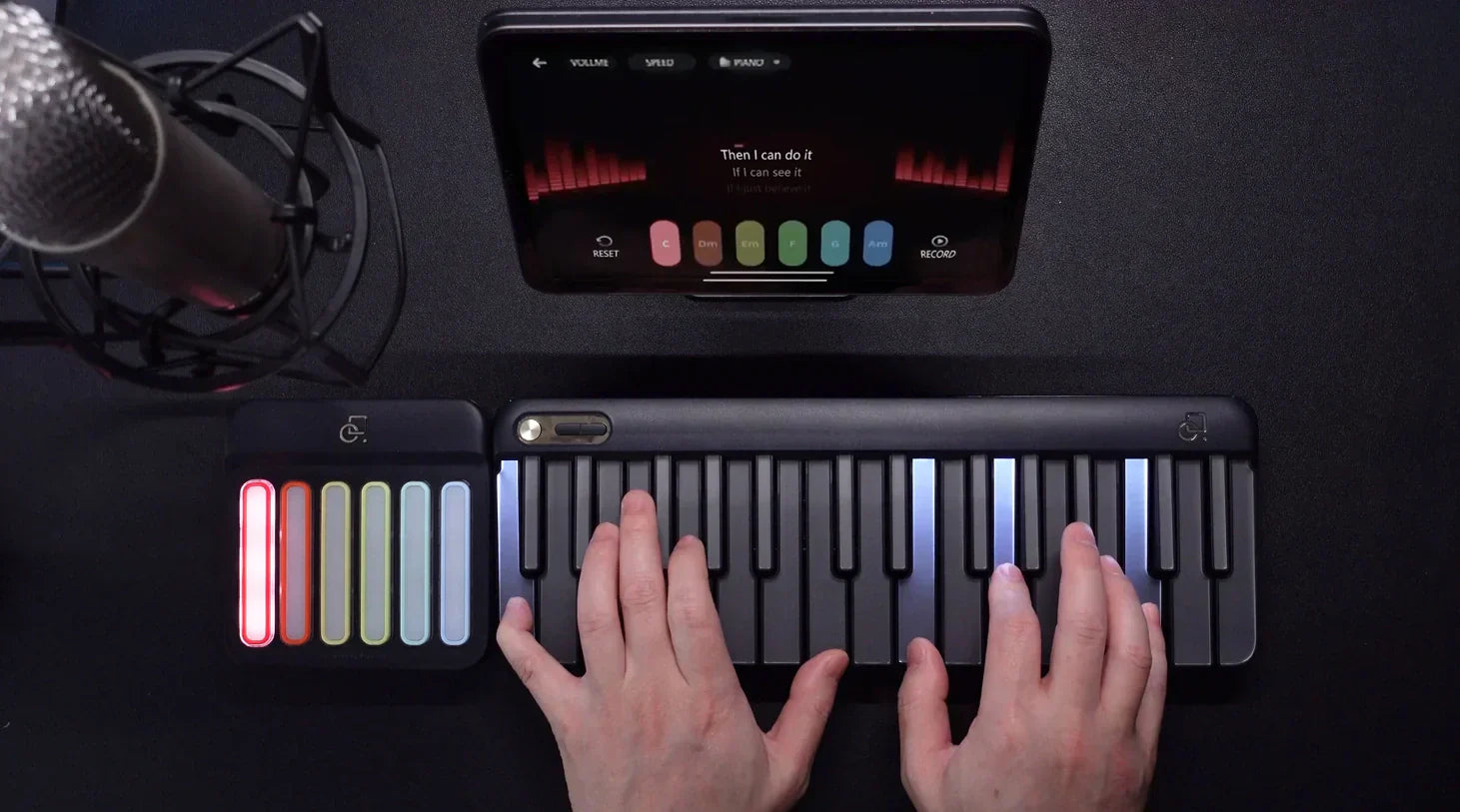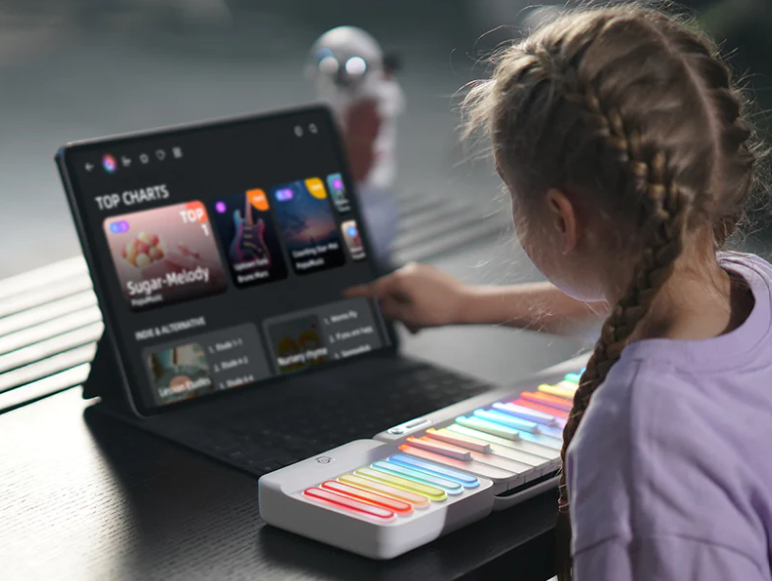
If you’ve ever searched for a piano to start learning on, chances are you’ve come across two terms that sound similar but mean very different things: digital pianos and keyboards. To make it more confusing, both often come in portable versions so how do you know what’s right for you?
The short answer: not all portable pianos are built equally, and understanding their differences can make a huge impact on your learning experience.
A portable digital piano gives you the tone and feel of an acoustic piano, but in a compact, lightweight design.
It’s meant to be moved easily perfect for small apartments, travel, or anyone who wants to learn without committing to a heavy full-sized instrument. These often support MIDI, connect to learning apps, and focus on piano realism.
A typical keyboard, on the other hand, is more of a general-purpose instrument. It’s lighter, often cheaper, and loaded with sounds and rhythms but not always ideal for serious piano training.
A portable digital piano is a compact, lightweight instrument that delivers the sound and playing feel of a traditional piano without the bulk or weight. Unlike upright or acoustic models, it’s designed for mobility and flexibility, making it ideal for modern learners and creative spaces.
Whether you're a beginner practicing in your bedroom, a college student in a dorm, or a music creator on the move, a portable digital piano lets you play wherever inspiration strikes. You can:
Set it up in small living spaces
Pack it for road trips or performances
Use it in shared spaces without needing soundproofing
Velocity-sensitive keys that respond dynamically to your touch
Authentic piano tones sampled from real acoustic instruments
App or software compatibility for lessons, recording, or composing
Weighted or semi-weighted action to mimic real piano resistance
Built-in speakers or headphone support for quiet practice
A keyboard piano often called an electric keyboard is a digital instrument designed to offer a wide variety of sounds, tones, and rhythms in a lightweight, affordable package.
While they may look similar to digital pianos at first glance, their purpose and functionality are quite different.
Entry-level and versatile
Usually equipped with 61 or fewer unweighted keys
Built for musical exploration rather than formal training
Commonly used for hobby play, kids’ learning, or basic composition
You’ll often find features like:
Built-in instrument sounds (piano, organ, synth, strings, etc.)
Accompaniment rhythms and demo songs
Built-in speakers
USB or audio outputs for external connection
Basic display screens and control panels
Unlike portable digital pianos, keyboard pianos are not typically made to replicate the feel or response of an acoustic piano. They may lack:
Weighted keys or graded hammer action
Realistic pedal response
Accurate dynamic control needed for classical or expressive play
They’re great for fun, flexibility, and casual play, but may fall short if your goal is to learn piano technique or transition to an acoustic instrument later.
While portable digital pianos and keyboard pianos might look similar from a distance, they’re built with very different goals in mind. One is optimized for realistic piano learning; the other is designed for flexibility and fun.
|
Feature |
Portable Digital Piano |
Keyboard Piano |
|
Sound Realism |
High-quality sampled tones from real acoustic pianos |
Synthesized sounds with multiple instrument voices |
|
Key Feel |
Semi-weighted or fully weighted keys for better control |
Often unweighted and springy; not piano-like |
|
Learning Intent |
Built for structured piano progression and practice |
Great for exploration, casual play, or kids’ learning |
|
Size & Portability |
Compact but purpose-built for serious learners |
Usually lighter but designed more for playability |
|
MIDI/DAW Support |
Commonly includes Bluetooth or USB MIDI connectivity |
Varies some models include it, others don’t |
If your goal is to learn piano properly, especially as a beginner, the feel and response of the keys really matters.
A digital piano gives you the right resistance and sound feedback to develop proper technique and finger strength. A keyboard, while fun and portable, may not teach those fundamentals as effectively.
If you’re just starting your musical journey, choosing between a keyboard and a portable digital piano comes down to your goals and how you want to learn.
A keyboard piano is ideal if you want to casually explore music, try out different sounds, or introduce a child to musical play. It's:
Lightweight and affordable
Fun to experiment with
Packed with tones, rhythms, and effects
But while it’s great for dabbling, a keyboard might not support long-term skill development or proper piano technique.
A portable digital piano, on the other hand, is built for people who genuinely want to learn how to play piano. It provides:
A more realistic playing experience
Key action and responsiveness closer to an acoustic piano
A stronger foundation for finger control, musicality, and progression
Today’s learners don’t want to sit through hours of dry music theory they want a piano experience that’s fun, flexible, and beginner-friendly. That’s where smart portable pianos like PopuPiano come in.
PopuPiano isn’t just a compact keyboard. It’s a modern hybrid that blends piano fundamentals with interactive learning, visual guidance, and gaming-style motivation all in one portable setup.
Modular Design: Start with a 25-key main keyboard and a chord pad, and add the expansion module later for full-range two-hand play.
Light-Up Key Guidance: No need to read sheet music just follow the lights to play your favorite songs instantly.
Rhythm-Based Practice Games: Learn pitch, timing, and accuracy through gamified exercises that keep you engaged without getting overwhelmed.
Real-Time Feedback + Instructor Videos:
Tutorials guide you step-by-step, and the app gives instant feedback to help improve technique and timing.
Grows With You: From beginner to advanced player, PopuPiano’s modular layout and MIDI capabilities let you expand your setup and even use it with professional DAWs like Logic or Cubase.
One of the biggest advantages of PopuPiano is how effortlessly it fits into your lifestyle. Whether you're practicing at home, jamming in a dorm room, or creating on the move, PopuPiano is designed to go wherever you do.
Battery-powered: No wall outlet required practice anywhere, anytime
Bluetooth MIDI: Connect wirelessly to your phone, tablet, or laptop in seconds
Compact and lightweight: Easy to carry in a backpack or gig bag
Follow glowing lights through songs
Learn chords, melody, and rhythm
Practice with rhythm games and tutorials
But if you want to go beyond the app? No problem.
PopuPiano is also a fully functional MIDI controller, meaning it integrates with:
GarageBand
Logic Pro X
Cubase
FL Studio
And other DAWs
So whether you're learning your first chords or composing a full track, PopuPiano adapts to how you create.
Whether you're a beginner with big goals or a hobbyist looking to reconnect with music, PopuPiano offers:
Real piano playability
Smart learning tools
Creative flexibility
without the bulk or cost of traditional pianos.
Nope! PopuPiano is designed for absolute beginners. You don’t need to read sheet music or memorize scales. Just follow the glowing lights and interactive tutorials to start playing real songs right away.
Yes. While the PopuMusic app unlocks guided lessons, song libraries, and rhythm games, PopuPiano can also function as a Bluetooth MIDI controller. You can use it with other music software like GarageBand or Logic if you prefer.
The LED lights show you exactly which keys to press so instead of staring at notes, you just follow the pattern. It’s an intuitive, visual way to build muscle memory and understand melody, chords, and rhythm.
Both! The app and keyboard are designed to be friendly for kids, teens, and adult learners. Whether you're picking up piano for the first time or getting back into it, PopuPiano offers an engaging and low-pressure way to learn.
Yes. PopuPiano is MIDI-compatible, meaning you can plug into DAWs (Digital Audio Workstations) like Cubase, Logic Pro, or FL Studio to record, compose, and edit your own music just like a pro.
Both digital pianos and keyboards have value especially for new learners. Keyboards offer flexibility and fun, while digital pianos provide more realism and structure.
But if you're looking for a tool that blends piano learning, creativity, and portability, a smart portable piano like PopuPiano gives you the best of both worlds. You’ll learn faster, stay more motivated, and enjoy every step of the journey.
Leer más

How to Play Piano Songs on a Small MIDI Keyboard (Beginner's Guide + Smart Tools)
How to Play Piano Songs on a Small MIDI Keyboard (Beginner's Guide + Smart Tools) If you think a small MIDI keyboard can’t teach you how to play real piano songs think again. With today’s smart...

What’s the Difference Between a Piano and a Keyboard? A Clear Beginner’s Guide
If you’re just starting to explore music, you’ve probably asked yourself:“Is a keyboard the same as a piano?” At first glance, the two may look similar they both have black and white keys, can be u...